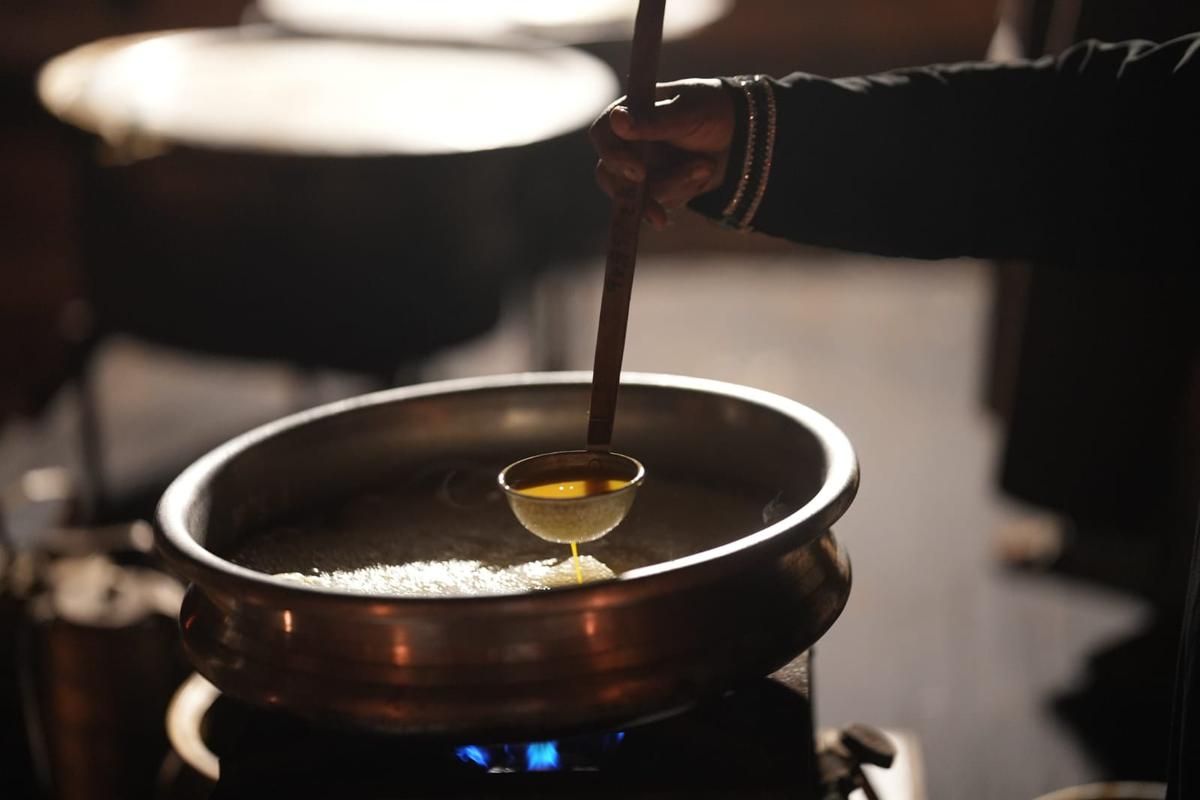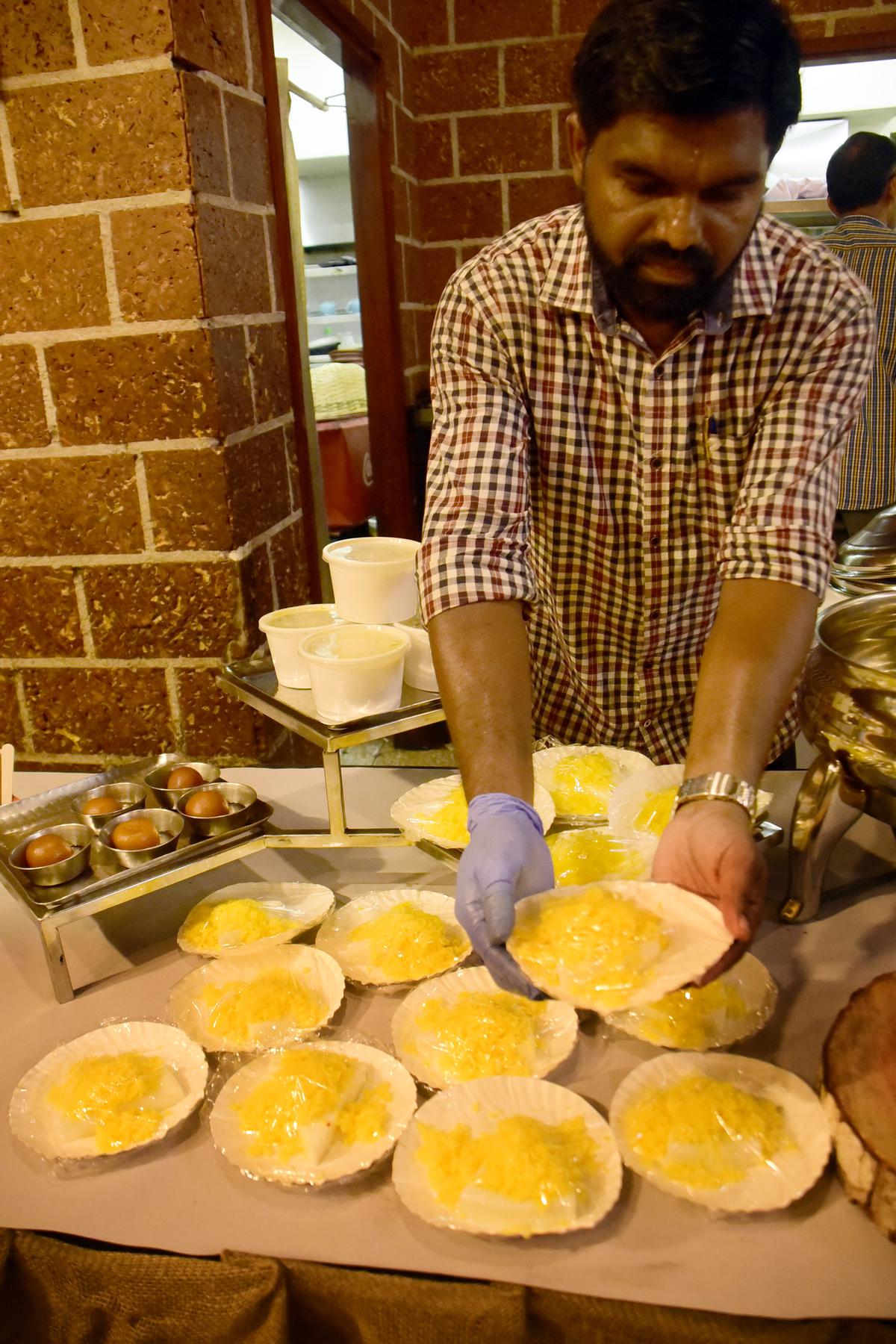Muttamaala, a signature dish from Malabar
| Photo Credit: K. Ragesh
Heaps of golden-coloured noodle-like strands served on a whitish marble-like base make their appearance in many bakeries in Kerala during this time of the year. It is only made on special occasions or during Ramzan, Called Muttamaala, the literal translation of which is ‘egg chain’ or ‘egg necklace’, this is a signature dish from Malabar that carries the flavour of trade winds that blew in from distant lands, bringing with them explorers, traders, missionaries and mercenaries.
Kozhikode on the Malabar coast, once the port of call for ships from China, Portugal, West Asia and Africa, was where Portuguese explorer Vasco da Gama landed in 1498 for God, gold and glory. Missionaries and traders followed. One of the stories about the Muttamala goes that nuns from Portugal used to starch their habit with egg whites. To prevent wasting the egg yolk, they began using it to make Muttamaala, called Fio de Ovos in Portuguese.

Muttamaala being made by Abida Rasheed
| Photo Credit:
Milan Soman
Made by cooking egg yolk in sugar syrup flavoured with cardamom, the Muttamaala soon found its way into Muslim households in Kozhikode and Kannur. Abida Rasheed, an ambassador of Moplah cuisine, says making Muttamaala is a laborious task that requires patience and expertise. She recalls that it was a special treat when she was a child. “We needed at least 50 eggs to make it for large families. In those days, one could not buy eggs from a shop. We had to collect the eggs laid by free-ranging hens in our homestead and keep them aside to make Muttamaala. I recall my mother and grandmother making it in a large uruli at home.”
After the yolks are collected for the Muttamaala, the remaining egg whites are beaten with the sugar syrup, poured into flat plates and steamed. This is the marble-like surkka that is served with the Muttamaala.
Abida feels that the presence of Mahe, a French colony, may also have influenced the culinary traditions of the region.
The making of the Muttamaala
Abida explains that the temperature of the sugar syrup has to be just right to get the right texture of the dessert. “I learned to make this from my mother and grandmother in our kitchen. In those days, it was cooked in an uruli on a firewood stove lit by dried coconut spathes.” The spathes would be removed or added to control the temperature.
Sugar and water were boiled to form a syrup. In the meantime, the egg yolks were separated and kept ready. As soon as bubbles appeared on the syrup, the egg was drizzled into the syrup as threads through the hole of a dried coconut shell or a ladle with a coconut shell that had a hole bored into it at the bottom. Then the heat would be reduced and the strings would sink into the syrup to be cooked. Once, it was cooked, it was drained from the syrup and kept aside.
“The egg whites are beaten and mixed with the sugar syrup with a pinch of cardamom. It is poured into a deep plate or flat-bottom container and steamed to make the surka,” says Abida. Now an icing bag or a squeeze bottle is used. “Even for a small family, one would require about 20 eggs to make Muttamaala. It would take about half an hour to make it,” she says.
Nazaneen Jalaludheen, the author of A Kitchen Full of Stories, remembers her grandmother Ummi Abdulla, the grand dame of Moplah cuisine, making Muttamaala on special occasions. “She used to pour the beaten egg yolk into the uruli through a coconut ladle in which a hole had been made. As it got cooked in the sugar syrup, she would carefully keep it aside in a colander to drain,” says Nazaneen, adding, “It is an acquired taste. Now, it is a must for any festive occasion in Malabar.”
Abida cautions that while making the Muttamaala, the white cords called chalazae, on both sides of the yolk, should not fall in with the yolk. “Each egg has to be broken, the white separated carefully before the yolk is added to the bowl. Even a little bit of the white would alter the texture of the Muttamaala and the threads might break,” she elaborates.

Muttamaala being packed at Adaminte Chayakkada restaurant in Kozhikode
| Photo Credit:
K Ragesh
The dexterity in making the Muttamaala is what writer and translator Fehmida Zakeer remembers while talking about her grandmother who would make it on special occasions. “However, this is not unique to Malabar. Wherever the Portuguese went, one can see versions of this in those places. In Goa, it is called Letria. Versions of this are also seen in Brazil, Cambodia, Thailand (Foi thong), Malaysia and Japan,” explains Fehimida who hails from Kannur.
As you bite into the lightly sweetened strands of the Muttamaala and the surka, what you are savouring is a centuries-old recipe that has survived the onslaught of time and change in tastes.


.jpg)

